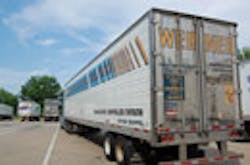The ongoing drumbeat of regulatory change will continue place the heaviest pressure on the trucking industry’s ability to provide efficient freight service in the eyes of many carriers and experts – and most believe there will be no let up, despite the potential risks reduced freight efficiency poses to U.S. economic growth.
“The data from the Dept. of Transportation indicates fatalities and injuries due to truck crashes are at an all time low,” Chris Ferrell, director of the Tompkins Supply Chain Consortium told Fleet Owner.
“Yet there remains a huge push to tighten the industry’s safety regulations – especially with [the Federal Motor Carrier Safety Administration’s] new CSA [Compliance, Safety, Accountability] program and efforts to reform hours of service (HOS) – in the face of an absolute lack of need,” he added. “In many ways, it seems the government is cutting off its nose despite its face here.”
According to Tompkins’ recent Domestic Transportation Report, the transportation industry as a whole is contending with diminished capacity, higher regulations, rising equipment costs, a graying workforce, and an economy that is moving back on track but is not quite stable yet.
But Ferrell stressed that those trends take on far greater significance where the trucking industry is concerned because trucks haul about 70% of the freight in the U.S.
“The regulatory climate has become a huge headwind for trucking and this occurring at a time when the industry’s capacity is exceptionally tight,” he pointed out. That becomes a problem in terms of HOS reform “because the proposed rules reduce driving time and change the restart provisions, meaning the industry will need to put more trucks and drivers on the road – trucks and drivers it does not have.”
Carriers themselves are well aware of the enormously complex challenge posed by these regulatory initiatives.
In its second quarter earnings statement, TL carrier Werner Enterprises said “the most significant safety regulatory changes in our 55-year history are occurring over the next three years,” noting that CSA, proposed changes to HOS, the proposal to require electronic on-board recorders (EOBRs) on virtually all trucks “are expected to reduce, or have the effect of reducing, industry capacity.”
Werner went on to note that “capacity in our industry remains constrained by both economic and safety regulatory factors,” with the number of new trucks purchased between 2007 to 2010 falling well below historical replacement levels.
“This led to the oldest average industry truck age in 40 years by the end of 2010,” Werner added. “Carriers were compelled to upgrade their aging truck fleets which led to increased replacement purchases of new and later-model used trucks in 2011.”
As example of lengthening trade cycles, FTR Associates research indicates the average Class 8 age hovered around 8.12 years in 2000, but by 2010, had jumped to over 9.43 years and is expected to pass the 9.5-year mark by the end of this year.
The age factor alone is what’s driving much of the surge in new truck orders and sales, noted Eric Starks, FTR’s president, and as a result, the firm expects total North American Class 8 factory shipments to top 259,000 units this year then surpass 299,000 units in 2012 – a significant increase over the 153,969 units shipped in 2010.
However, Werner does not believe that industry fleet growth is occurring, as some carriers are already struggling to finance the replacement truck upgrade due to the large pricing gap between emissions-complaint new trucks compared to the low value of record-old trucks.
In terms of its own operation, Werner plans to keep its fleet size capped at 7,300 trucks for the foreseeable future. “We will continue to strengthen and redesign our truckload freight network to optimize and maximize increasing freight opportunities without adding trucks,” the carrier said.
About the Author
Sean Kilcarr
Editor in Chief
Sean Kilcarr is a former longtime FleetOwner senior editor who wrote for the publication from 2000 to 2018. He served as editor-in-chief from 2017 to 2018.
